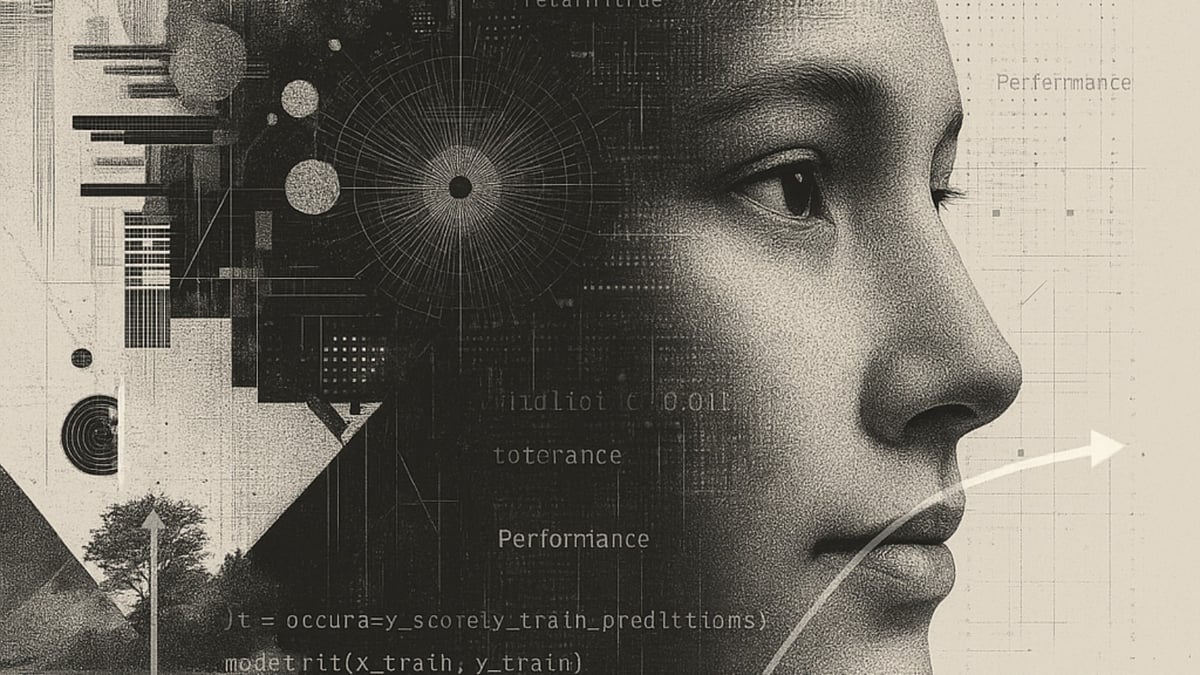Event Recap
July 7, 2025
Reimagining Economic Progress in the Age of AI

# AI Economics
# Career
# Future of Work
Insights from OpenAI's Forum "Making AI Work For Everyone" and Its Implications for Societal Transformation

Cezary Gesikowski

The intersection of technological innovation and human potential has always fascinated me. Recently, this fascination led me to virtually attend OpenA Forum's enlightening event, "Making AI Work For Everyone," featuring Kevin Weil, Chief Product Officer at OpenAI, and Erik Brynjolfsson, Stanford's distinguished expert on the digital economy. Their ideas resonated with many questions I've been considering about the impacts of AI on global socio-economic structures and organizational transformation. The conversation was revelatory, challenging fundamental assumptions about measuring, implementing, and conceptualizing AI in our rapidly evolving digital world.
Examining their insights, I decided to reflect on how these concepts could reshape our collective approach to technology integration, particularly in sectors often undervalued by traditional economic metrics like the public service.

Image by the author via ChatGPT
AI as a General-Purpose Technology
Brynjolfsson framed AI as part of a continuum of general-purpose technologies—comparable to electricity, steam power, and the internet—capable of fundamentally reshaping society and the economy. While transformative, these technologies typically follow a predictable adoption pattern that exhibits slow growth before profound changes enable widespread integration.
A particularly compelling moment was Brynjolfsson's introduction of the "productivity J-curve," describing how transformative technologies initially face slow adoption until significant organizational and process-oriented shifts occur:
"It literally took 30 years for a generation of managers to retire, and then they started to realize we don't need one big electric motor in the middle with pulleys and crankshafts. We can have separate electric motors for each piece of equipment, arranged efficiently in an assembly line, doubling or tripling productivity."-- Brynjolfsson
AI similarly demands comprehensive reimagination—not mere incremental integration—to unlock its full transformative potential. Organizations need to embrace AI with open minds and be willing to fundamentally restructure workflows and organizational hierarchies.
Image: The J-Curve of Change illustrates the typical trajectory of productivity, morale, and quality during organizational transformation. Initially stable, these factors typically dip as teams adjust to new processes or tools. With time and adaptation, performance rebounds—often surpassing original levels—highlighting the long-term gains of well-managed change. | Created by the author via ChatGPT.
As someone recently pointed out, electricity was just a hazardous phenomenon that became viable only when lightbulbs and electric motors were invented to tangibly harness its potential. Since then, this once unfathomable power has been illuminating streets, warming our homes, automating factories, and powering the numerous time and effort-saving devices we continue to invent, including the latest frontier AI models like ChatGPT.
The Innovation Imperative: Reviving Dynamism
I was particularly intrigued to hear Brynjolfsson's highlighted concerns about declining innovation momentum within the American business ecosystem, noting this slowdown threatens long-term economic vitality and global competitiveness:
"America has never been successful by freezing in place. You've always got to embrace change. To leverage new technologies effectively, you need new companies or radically new processes within existing companies, which currently isn't happening fast enough."-- Brynjolfsson
This message resonated strongly with my professional experience, emphasizing the importance of cultivating ecosystems that welcome disruption as opportunities rather than threats. Businesses and organizations remain dynamic and thrive when they prioritize encouraging entrepreneurial activities, funding innovative ventures, and creating incentives that reward creative risk-taking.
Organizational dynamism is key to my transformational work in implementing innovation, automation, and AI acceleration at the Public Service of Canada. Research confirms my own experience and anecdotal observations: the greatest obstacle to change is rigid work cultures that incentivize permission-seeking rather than experimentation among their employees.
People are always at the heart of any meaningful change, and the best way to ensure AI adoption achieves the benefits we seek is to design human-centred experiences that foster innovative mindsets.
Rethinking Economic Measurement: GDP-B
The Gross Domestic Product (GDP) represents the total monetary value of all finished goods and services produced within a country's borders during a specific period, typically annually. It has long served as a key indicator of the economic strength and performance of national governments. However, I have always found this singular measurement, focussed on costs and spending, very limiting.
Over the years, I have often heard about the need for better economic indicators in numerous conversations with international economists. To my delight, the most thought-provoking idea in the OpenAI Forum discussion was the introduction of GDP-B, a revolutionary concept proposed by Brynjolfsson to measure economic benefits (the B in the acronym) rather than merely accounting for costs.
"GDP measures many things, but not services with zero price, despite their substantial utility. The average American spends half their waking hours on digital screens, benefiting immensely from free services like search engines and AI assistants. GDP-B quantifies this previously invisible consumer surplus."-- Brynjolfsson
This innovative metric profoundly impacts sectors like public services and nonprofits, whose contributions are often inadequately captured by traditional economic measures. Implementing GDP-B would provide a richer and more accurate assessment of economic productivity and well-being, especially in areas providing substantial intangible value.
While this may still be an exotic concept for some Americans, other parts of the world have long embraced alternative economic measures that better capture the complexities of societal well-being and sustainability. The Organisation for Economic Co-operation and Development (OECD) has developed several frameworks and indicators that provide a more comprehensive view of economic and social progress, including:
- OECD Well-being Framework: This framework assesses well-being across multiple dimensions, including income, health, education, environment, and social connections. It emphasizes current well-being and the resources contributing to future well-being, such as natural, human, and social capital.
- Inclusive Growth Framework: This framework aims to ensure that economic growth translates into improved living standards for all. It introduces the concept of Multidimensional Living Standards (MDLS). MDLS combines monetary aspects like income with non-monetary factors such as health and employment, providing a more nuanced picture of societal progress.
- OECD Better Life Index: An interactive tool that allows individuals to compare countries based on personal priorities across various well-being indicators, including housing, work-life balance, and civic engagement. This index promotes a more personalized understanding of quality of life beyond economic metrics.
AI for Inclusive Prosperity
The Forum discussion outlined critical pathways to achieving inclusive prosperity through AI: employing innovative GDP-B, fostering entrepreneurial dynamism, and redefining intelligence benchmarks.
AI's potential for societal good is evident in numerous real-world examples. For instance, AI-powered language translation has enabled organizations like Doctors Without Borders to communicate internationally in crisis zones, significantly improving coordination and outcomes by overcoming language barriers. Predictive analytics have similarly empowered social services agencies in cities such as New York, proactively addressing community needs and efficiently allocating resources.
These examples illustrate AI's potential when thoughtfully integrated, reinforcing my professional commitment to leveraging AI for enhanced societal benefit, particularly in traditionally underserved sectors. However, a palpable shift exists in how governments are positioning AI.
This shift is most evident in Canada, which recently shifted political gears, placing the former Governor of the Bank of Canada and the Bank of England, Mark Carney, to lead the country in the climate of global economic unrest and uncertainty. Wasting no time, the newly minted Prime Minister has created the Ministry of Artificial Intelligence and Digital Innovation, signalling the growing socio-economic significance of AI and digital technologies.
Refocusing the government towards increased productivity and outcomes also indicates a strong step linking AI deployment to increased benefits beyond the classical economic indicators like GDP. Prime Minister Carney has clearly outlined the importance of AI in his Mandate Letter, the government's plan to find real solutions to the challenges facing citizens:
"... the transformative nature of AI will create opportunities for millions of Canadians to find new rewarding careers – provided they have timely access to the education and training they need to develop the necessary skills.
Government itself must become much more productive by deploying AI at scale, by focusing on results over spending, and by using scarce tax dollars to catalyse multiples of private investment." – The Rt. Hon. Mark Carney, Prime Minister of Canada, Mandate Letter.
While the new Minister of AI and Digital Innovation is awaiting direction from the Prime Minister, there is hope the incentives for businesses and the public sector to adopt AI will revitalize economic dynamics across Canada and around the world. The technologically-inspired shift in global economic focus is further bolstered by the recent joint statement of finance ministers and central bank governors at a G7 summit in Canada, Alberta:
"We deepened our understanding of prospects for AI to raise productivity growth, and of the policies needed to realize the benefits. We appreciate the framework provided by the OECD to better quantify and monitor AI-driven productivity gains. We recognized the benefits of AI for the financial sector and the need to monitor and assess potential risks to financial stability as AI adoption further increases." – G7 Finance Ministers and Central Bank Governors' Communiqué, May 22, 2025, Banff, Alberta, Canada.
No matter where we live, the socio-economic impact of emerging technological innovation is already affecting us. In some parts of the globe, the change is slower and more subtle. But among the leaders of the top economies of the world, there is no doubt that AI will be a key factor in creating the economy of the future, driving widespread adoption of new technologies and digital innovation, and building the infrastructure needed to support future generations of employees and citizens.
The joint G7 statement is an early indication of where government intervention is leaning. It also hints that most governments will seek to explore the potential of AI as an enabler of transformational changes in public sector bureaucracies of all jurisdictions worldwide.
Countries seeking to rapidly scale their AI adoption would be wise to follow the footsteps of the United Arab Emirates (UAE), which recently announced the Startage UAE initiative will provide national universal access to ChatGPT Plus. As the first country to make OpenAI technology free across the entire nation, UAE is securing its stake in the AI race to ensure the most important technology of the 21st century benefits all its citizens, the way free public education advanced every nation where it has been implemented since the 19th century.
Toward Human-AI Partnership
One of the most fascinating aspects of recent AI advancements has been my renewed interest in examining the limits of human intelligence. As renowned historian and public intellectual Youval Noah Harari noted in his seminal book Sapiens, we homo sapiens owe much to our ability to think, learn, and collaborate not just as individuals but as a species. It's that ability that makes us the masters of Earth—for better or worse.
Examining the power of AI and the information age in his latest book, Nexus, Harari impresses on us the significance of synthetic intelligence emerging as a new superpower to rival human intelligence. And if we are not careful, potentially overshadowing the millennia of our planetary dominance.
But as I reflect on Brynjolfsson's productivity J-curve, today's accelerated information flow, advanced analytics, and collaborative tools like Slack and Microsoft Teams, I sense a potential for a quicker transition from initial adoption to comprehensive transformation compared to historical precedents. Beyond new socio-economic approaches, most private and public sector organizations are gearing up for AI adoption, seeking new ways to leverage and measure machine intelligence in traditionally human-centred systems.
I was particularly intrigued by Kevin Weil challenging the traditional benchmarks for evaluating AI, advocating for a broader understanding of intelligence that transcends human-centric measures. Perhaps AI systems are intelligent in entirely different ways.
“My calculator does things I can't. Google searches billions of documents instantly. Even chimpanzees have better short-term memory than humans."-- Brynjolfsson
Brynjolfsson expanded on this by emphasizing complementarity—designing AI systems to augment rather than replace human capabilities. He argues that AI can complement humans in performing tasks and enhancing human value.
This concept has been essential in my work, underscoring successful AI deployments as partnerships between human judgment and AI capabilities. It encourages focusing on AI's unique strengths, enabling humans to devote more attention to tasks requiring creativity, empathy, and nuanced decision-making. The challenge of implementing AI to benefit organizations starts with fostering organizational cultures that empower people to experiment beyond the status quo.
I was glad both speakers agreed on the need for more transparent and collaborative human-AI interactions. Brynjolfsson cited medical diagnostics as a potent example, noting that opaque AI systems hindered doctors' ability to trust and effectively utilize AI recommendations. This illustrated the critical importance of interpretability in fostering trust and effective human-AI collaboration. Similarly, Weil discussed how OpenAI continuously works to enhance the interpretability and accountability of its models to encourage responsible adoption and deployment.
For me, the critical factor remains cultivating "organizational ambidexterity"—the capacity to simultaneously optimize current processes and explore innovative approaches. Organizations that master this dual capability are better positioned to quickly navigate the initial productivity plateau and accelerate toward significant productivity gains. Transparency and collaboration are powerful antidotes to growing complexity and ambiguity contributing to economic and organizational uncertainty. This is where AI can have significant impacts by addressing the technical debt almost all organizations carry while expanding the innovative technological possibilities for the future.
Guiding Technological Co-Evolution
We stand at an inflection point where AI's true potential lies in its partnership with human intelligence. Embracing complementarity, fostering dynamism, and adopting innovative metrics like GDP-B positions us to ensure AI serves as a force for collective benefit.
The OpenAI Forum discussion offered a valuable framework for guiding purposeful AI integration. Technology's trajectory isn't predetermined; it is shaped by deliberate choices around measurement, implementation, and intent. Our journey with AI is an ongoing collaborative effort, and we are critical in steering its direction.
I invite you to reflect on your organization's approach to AI. Are you merely enhancing existing processes or genuinely reimagining your operations to leverage AI's strengths? How might adopting concepts like GDP-B transform your understanding of value creation? Lastly, how can you foster organizational ambidexterity to effectively navigate the productivity J-curve?
I welcome your insights, experiences, and contributions as we navigate this transformative landscape together.
Further Research
For those interested in exploring Erik Brynjolfsson's work further, I would also highly recommend the recently launched report that Brynjolfsson co-authored, the 2025 AI Index Report, a landmark publication by Stanford Human-Centered AI (HAI) he mentions in the discussion. The report provides extensive data, analysis, and insights into AI's trajectory, economic implications, and global societal impacts.
The following are additional resources providing deeper insights into his groundbreaking research:
- Stanford HAI - Erik Brynjolfsson: Detailed information on Brynjolfsson's research initiatives and contributions to digital economics.
- Machines of Mind: The Case for an AI-powered Productivity Boom: An article discussing Brynjolfsson's predictions about AI-driven productivity.
- Generative AI Boost Productivity Without Replacing Workers: Insights from Stanford Institute for Economic Policy Research on AI's augmentation potential.
- How Should We Measure the Digital Economy?: Harvard Business Review article detailing GDP-B and digital value measurement.
Note: This article has greatly benefited from ChatGPT Deep Search on Erik Brynjolfsson, which I am happy to make available to OpenAI Forum members and AI enthusiasts here: https://chatgpt.com/s/dr_682c5e23f8bc819187b02c26508601a4
2
Comments (0)
Popular
Dive in
Related
35:58
Video
Event Replay: Stack Overflow & Learning to Code in the Age of AI
By Romain Huet • Nov 14th, 2025 • Views 755
40:53
Video
Unlocking the Economic Impact of AI in Southeast Asia
By Ronnie Chatterji • Aug 6th, 2025 • Views 352
40:53
Video
Unlocking the Economic Impact of AI in Southeast Asia
By Ronnie Chatterji • Aug 6th, 2025 • Views 352
35:58
Video
Event Replay: Stack Overflow & Learning to Code in the Age of AI
By Romain Huet • Nov 14th, 2025 • Views 755

